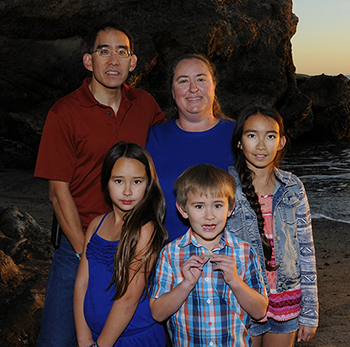Steve Gee, an electrical engineer in the District 5 office, poses with his family two years ago.
By Colin Jones
District 5 Public Affairs Manager
Steve Gee is a bicycling fiend, often seen riding his road bike to, from and around the Caltrans District 5 office where he works as an electrical engineer handling intelligent transportation systems (ITS) elements such as changeable message signs, closed-circuit television and microwave vehicle detection stations.
Steve was diagnosed with polycystic kidney disease (PKD) in college after his father found out he got it. PKD, a genetic disease that runs on his father's side of the family, causes multiple cysts to form on kidneys. The cysts cause the kidneys to grow (up to size of a football) and destroy their ability to remove toxins from the blood.
Steve’s grandfather also had PDK, and died from the disease in middle age because there was no dialysis in the 1950s. Gee’s father also died from PKD-related complications while he was on dialysis.
Because they too inherited PKD, Steve’s two brothers are not eligible to donate a kidney to him. His older brother had a kidney transplant roughly two years ago after waiting for multiple years. Steve is on the transplant list at Stanford Medical Center, but for a person with type A-plus blood, the average wait time for a kidney there is six to eight years.
At this point, Steve’s kidneys are down to about 14 percent function. This is considered stage 5 chronic kidney disease, or End Stage Renal Disease (ESRD). His doctor has told him to start dialysis early next year or even sooner, depending on the symptoms and side effects of ESRD. He also will need multiple surgeries to prepare for peritoneal dialysis.
The only choice now is finding a kidney donor in the next few months or going on dialysis until receiving a kidney transplant. Dialysis requires being hooked to a machine every night for 10 to 12 hours to remove the toxins from his blood. Survival rates for people on dialysis vary from five to 10 years. (Read more at https://www.kidney.org/atoz/content/dialysisinfo).
While dialysis does take over some of the functions of the failed kidneys, it’s not a cure and a strict diet must followed. Also, close monitoring of the blood chemistry of a person on dialysis is required.
A kidney transplant from a donor would allow Steve to avoid dialysis and improve his long-term health and quality of life. Even if a person is not an exact match, they can donate via a paired kidney exchange.
Steve, originally from Sunnyvale and married for 21 years with three kids, one of whom is autistic, remains positive and active. He met his wife at a Cal Poly Country Western Line dancing class and still enjoys the concert scene around the Central Coast.
He studied electrical engineering and manufacturing engineering at California Polytechnic State University, San Luis Obispo.
Check out Steve’s Facebook page, “Daddy Needs a Kidney Team Steve Gee,” and a recent Go Fund Me page.
He can also be contacted at (805) 270-7126 for anyone interested in donating a kidney.

